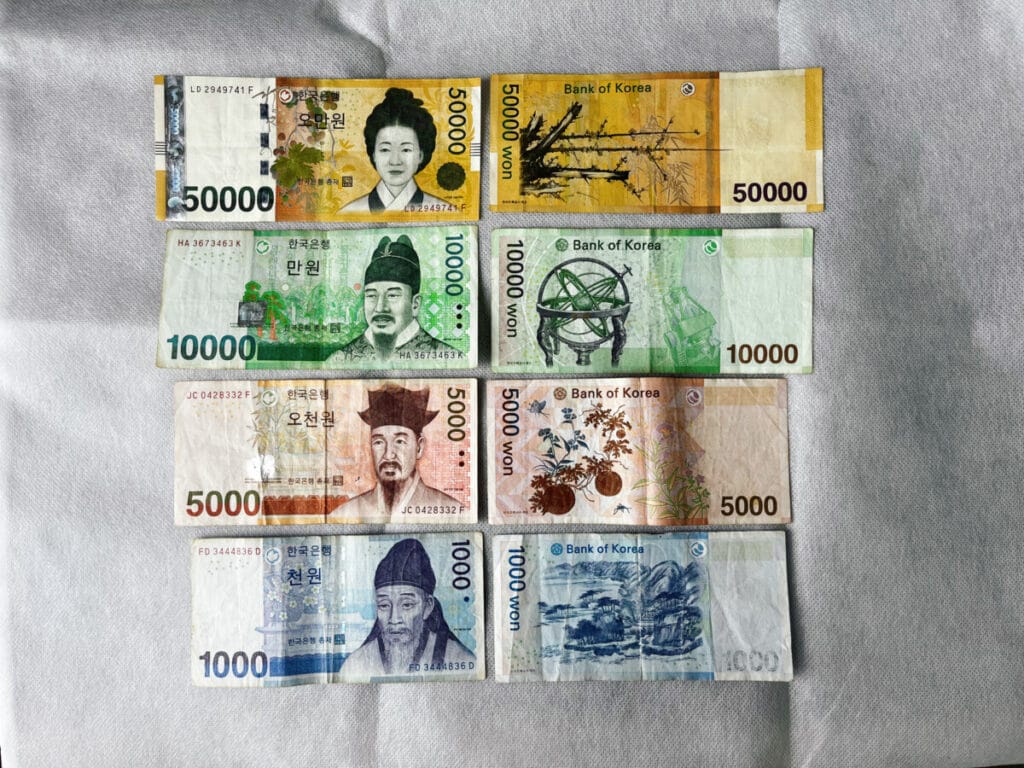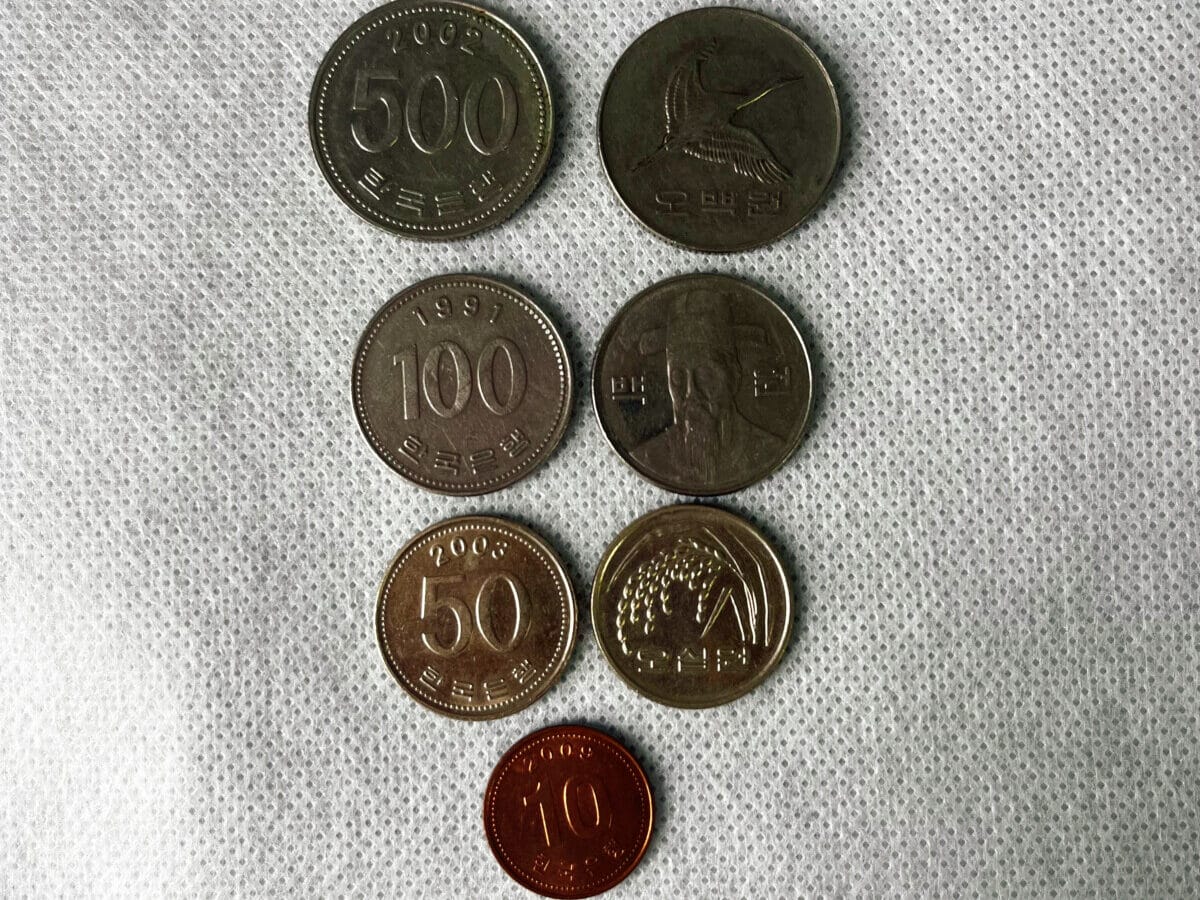Korean Currency
If you’re visiting Korea, you might be wondering whether you’ll actually need Korean currency. The short answer? Not always. But sometimes, yes.
South Korea has become a largely cashless society. Credit cards, debit cards, and mobile payments like Samsung Pay and Kakao Pay are widely accepted, even at small restaurants.
Kiosks are now the norm in most places – whether you’re ordering fast food, café drinks, or even meals at a traditional-style Korean BBQ restaurant. These kiosks almost always accept cards and digital payments.
Still, there are a few situations where Korean currency (cash) can come in handy. For example, if you’re buying street food at a traditional market or at a pop-up festival, there might be vendors who only accept cash. Also, some coin lockers, old vending machines, or tiny countryside stalls may still require physical money.
If you’re a tourist without a Korean bank account, bank transfers won’t be an option for you. So having a small amount of Korean currency is a smart backup.
Useful Korean Words for Money
If you’re handling Korean currency, it helps to know how to talk about money in Korean. Here are a few simple but useful words you might hear or see
- Money : 돈 [don]
- Card : 카드 [card]
- Cash : 현금 [hyeon-geum]
Most Koreans, especially in cities, understand basic English words like “cash” and “card,” but knowing the Korean pronunciation can help when you’re using self-service kiosks or reading small signs in shops.
Korean Currency in Global Comparison (2025)
The official currency of South Korea is the won (₩). In writing, you’ll often see it as “KRW” or with the won symbol (₩) in front of numbers.
As of September 2025, here’s a general comparison of exchange rates:
- 1 USD = 1,390 KRW
- 1 JPY (Japanese Yen) = 9.2 KRW
- 1 CNY (Chinese Yuan) = 191 KRW
Korea’s economy is stable, and Korean currency is easy to exchange at banks, airport counters, or through currency exchange machines found in major tourist areas like Myeongdong and Hongdae. You can also find exchange booths in department stores and hotels.
While cards are convenient, it’s always wise to carry at least 20,000 to 50,000 won in cash when exploring new places, just in case.
BIlls

There are four main paper bills in Korean currency, each featuring a notable historical figure and beautiful traditional art.
₩50,000
This is the highest denomination in Korean currency. It features Shin Saimdang, a respected artist, poet, and calligrapher from the Joseon Dynasty. She is also known as the mother of Yi I (Yulgok), the Confucian scholar featured on the ₩5,000 bill.
It’s the most recently introduced banknote, released in 2009. Shin Saimdang is the first woman to appear on South Korean currency. The artwork on the note includes her paintings of grapes and butterflies, symbolizing wisdom and harmony.
₩10,000
The green ₩10,000 bill features King Sejong the Great, the 15th-century monarch best known for creating the Korean writing system, Hangul. He is one of the most admired figures in Korean history.
Behind him, you’ll see an astrological chart, reflecting his contributions to science and education.
₩5,000
This red-orange note features Yi I (Yulgok), a Confucian scholar and philosopher from the 16th century. He was a child prodigy and wrote significant texts on governance and ethics.
On the back of the bill, you’ll find an image of Ojukheon, his birthplace, and a well-preserved traditional house in Gangneung that many tourists visit today.
₩1,000
This blue note features Yi Hwang (Toegye), another famous Confucian scholar from the Joseon period.
The background shows Dosan Seowon, a Confucian academy that served as a center of learning and remains a historical site today.
Coins

Coins are less commonly used these days due to the rise of digital payments, but they’re still part of the currency system—especially useful when you need exact change for vending machines or coin lockers.
₩500
This is the highest value coin, silver in color, and features a graceful crane, symbolizing longevity and elegance in Korean culture.
₩100
The ₩100 coin features Admiral Yi Sun-sin, a naval hero who played a key role in defending Korea from Japanese invasions in the 16th century.
He is also the central figure in the popular historical war movie “The Admiral: Roaring Currents (명량)”, which broke box office records in Korea.
₩50
This coin features a rice stalk, symbolizing the importance of rice farming in Korean history and economy.
₩10
The smallest denomination in Korean currency. It features Dabotap, a stone pagoda from the famous Bulguksa Temple in Gyeongju, which is a UNESCO World Heritage site.
How much is the Squid Game cash prize when converted to USD?
If you have seen the Korean series Squid Game, you might be curious how much the cash prize is when converted to USD.
The amount of 45.6 billion won to USD is a whopping $35.6 million USD.
Tips for Handling Korean Currency
- ATMs are everywhere, including in convenience stores like GS25 and CU. Look for machines that display “Global ATM” or have English support.
- Currency exchange machines are available in tourist areas and even at some subway stations.
- Kiosks usually accept cards and sometimes mobile payments only. So don’t expect to pay with coins or bills.
- Tipping is not required in Korea, so you don’t need to carry small change for that purpose.
- Consider getting a T-money card (transportation card) and topping it up using Korean currency at convenience stores or machines.






